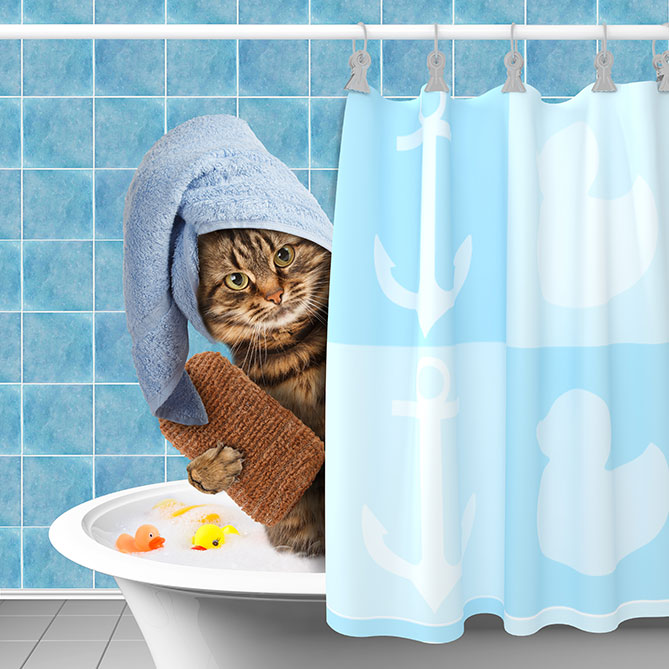If you’re a cat owner, you know that your feline friend can be pretty fastidious when it comes to the cleanliness department. When they aren’t sleeping, eating or exploring, they’re more than likely grooming – and we must admit that equipped with just a tongue, they don’t do a bad job.
However sometimes cats get themselves into strange situations, and their coats can take a bit of a bashing that a tongue alone can’t fix. This is where you come in to help.
Grooming is not just about giving your cat the most luscious coat in the land, but it also has a number of health benefits, such as:
- Preventing hairball formation.
- Stimulating oil production, encouraging a healthier, thicker coat.
- Giving you the chance to check for parasites and skin conditions.
- Providing you and your cat an excellent opportunity for bonding
If you have recently brought a kitten home, then you’re lucky – you can start getting them used to grooming from a young age. However, if you either haven’t groomed your cat before or you have adopted a fully grown feline, then the grooming process may take a little bit longer.
Here’s how to go about grooming your cat at home:
Get them accustomed to it
If you know anything about cats, you will know that they aren’t exactly going to saunter on over, plonk themselves on your lap, and start purring away as you brush them. Cats are creatures of habit, and trying to get immediately stuck into a grooming routine is not only going to result in many scratches, but can also stress out your kitty.
Instead, you should approach your cat when it is relaxed, perhaps after eating or when it’s lying in the sun, and spend short bursts of time gently grooming it. Start with five minute sessions where you softly brush them, talking, petting, and maybe even give them a treat at the end of the process. As your cat starts to get used to this, it should become easier and easier to get them relaxed during grooming over longer periods of time.
If your cat particularly dislikes being groomed, start with shorter, one minute grooming intervals, interspersed with petting and treats. This will require a lot of patience on your behalf, but remember – you want to try and make the entire process as enjoyable and stress free as possible!
Brushing the beast
Ok, we know they aren’t beasts – but they can be if you brush them incorrectly! Firstly, always remember to brush in the direction of hair growth, and be extra gentle around the stomach and chest regions. There are also different ways to brush longhaired and shorthaired cats:
Shorthaired
A fine toothed metal comb should be softly used from the tips of the head down to the tail. Remember to keep your eyes peeled for indicators of fleas and ticks. A soft bristled brush can be used to get rid of any loose hair that is hanging around.
Longhaired
A wide toothed comb should be used to gently disentangle any knots or dirt caught in their coast. A wire brush or bristled brush can then be used to get rid of extra fluff and hair. You could also use a soft toothbrush on your cat’s face for an absolutely flawless look.
Dematting
Your cat shouldn’t get tangles or matting if you are grooming it regularly; preventative grooming is the best solution. However, if your cat does get knots in its fur, you can try gently pulling apart the matt from the roots. This is a very delicate process! If there’s anything particularly stubborn, take your cat to be shaved at the veterinary clinic to avoid any harm or distress.
Bath time (gulp!)
We all know that cats generally detest anything to do with swimming, and this distaste definitely extends to bath time. Luckily, it’s normally unnecessary to bath your cat unless it has something sticky in its fur. If you do have the misfortune of having to undertake this terrifying task, this is how to go about it:
- Fill a small tub with warm water (not hot not cold) and place a mat at the bottom (so your kitty doesn’t slide around)
- Place your cat in the tub and spray it down, avoiding its face.
- Using cat-specific shampoo,start massaging from the head to tail (do not use human shampoo)
- Rinse thoroughly.
- Pat your cat dry with a towel.
Weapon care
Nail clipping can be a little precarious, so start off by getting your cat comfortable with its feet being handled. While you are petting it every day, spend some time sliding your hands down to its paws and gently squeezing them till their claws show. Your cat may get a little annoyed the first few times you do this, but they should soon get used to the idea. Once they’re comfortable having their feet touched, you can quickly and softly clip their claws using sharp clippers.







Leave A Comment